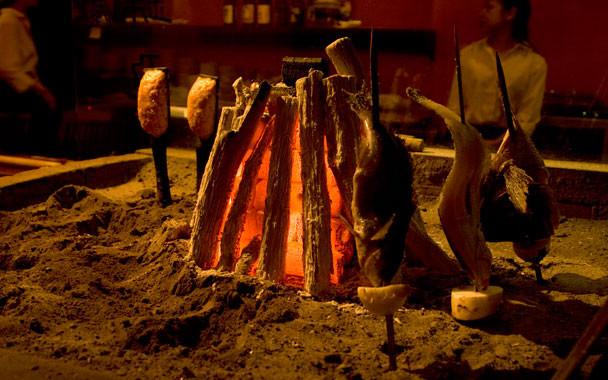Summertime is barbecue time, of course, but this year, instead of breaking out my trusty Weber, I decided to try my hand at a rustic form of grilling from Japan called robata. Translated as “around the fireplace,” robata taps the ancient Japanese custom of cooking in the irori, the traditional charcoal-fired hearth once found in every home. I first came across robata in restaurants in Japan; the technique still is not very well known in the U.S., but it seemed utterly simple—just charcoal, fish or meat, and salt. It embodies everything that Japanese cooking is about, achieving the sublime through humble means.
To learn how to cook robata, I enlisted the help of fourth-generation chef Jiro Iida, who runs the kitchen of Aburiya Kinnosuke in Manhattan, a branch of a Tokyo restaurant that specializes in this form of grilling. First I watched the masters at work, pulling up a seat along an L-shaped, burnished-wood dining counter. Chefs cooked in the open kitchen on the opposite side, one of them tending a pile of baton-shaped charcoal sitting on a sand-filled platform, the charcoal arranged like a fiery pyramid, a foot tall and glowing bright orange. I watched him flick sea salt on long skewers of fish, chicken, and meat, and plant the ends of the skewers into the sand so they would stand upright around the fire like soldiers at attention. They grilled slowly, with no billowing smoke or shooting flames. The chef waited. And waited. He angled the skewers closer to the pyramid. And waited some more.
The ingredients stood about six inches from the burning pyramid, roasting and caramelizing for about 25 to 30 minutes. The chef turned the skewers every five to ten minutes, feeling for doneness with his fingers. He controlled the heat the traditional way, by sprinkling salt on the charcoal to knock off ash and make it hotter, or by dripping a few drops of water on it to cool it down.
Chef Ida explained that when the food is too hot to touch, it’s ready. Chicken or beef is sliced, while cuts of fish are presented whole. Unlike a thick steak, which needs time to rest after grilling, robata dishes are served immediately, which also keeps the skin crispy. The red snapper I tasted was succulent, tender and perfectly cooked inside, the skin indeed taut and crispy. I added a drop of soy sauce and a little grated daikon to each bite. The chicken was also tender, its natural flavors accented by a delicate, caramelized barbecue sauce. The meat—delicious, soft, rich wagyu—had an irresistible aroma.
After I finished eating, Chef Iida showed me his technique for preparing momoyaki, or grilled chicken thigh, one of his most popular dishes. Grilling robata-style is simple but very subtle, and takes practice to get the feel for it. The process starts with binchotan, traditional oak charcoal that’s expensive—$5 a piece—and so hard that it rings like a tuning fork when you knock pieces together. Coated in downy white ash, it burns steadily for up to five hours. The charcoal is arranged in a pyramid so that its heat gently circulates around the foods. Because it creates this steady, enveloping heat, explained chef Iida, “binchotan develops the umami in ingredients.” Smoke doesn’t play a part in robata; binchotan is almost smokeless, and whatever smoke is produced escapes straight up and doesn’t influence the ingredients.
For his momoyaki, Iida uses the entire attached leg and thigh, deboned with the skin on. This dish is prepared two ways: With salt, lightly sprinkled on just before grilling; or with tare, Japanese-style barbecue sauce (see below). If he adds tare, he grills the chicken without salt and lightly brushes on the tare only at the end, so the sauce accents the meat but doesn’t overpower it. Either way, he sprays the chicken with sake before grilling, which gives it an appealing sheen.
The cooking times in the instructions below are approximate, and will vary by how hot the fire burns, the distance of the chicken to the fire, and other variables. Total cooking time will be about 30 minutes, but you’ll have to judge as you grill. The goal is to slowly grill and caramelize the chicken, the skin turning golden and crispy, the meat becoming tender and moist. The momoyaki is done when the skin is nicely seared and too hot to the touch, and the meat no longer feels pliant.



 Pinterest
Pinterest


